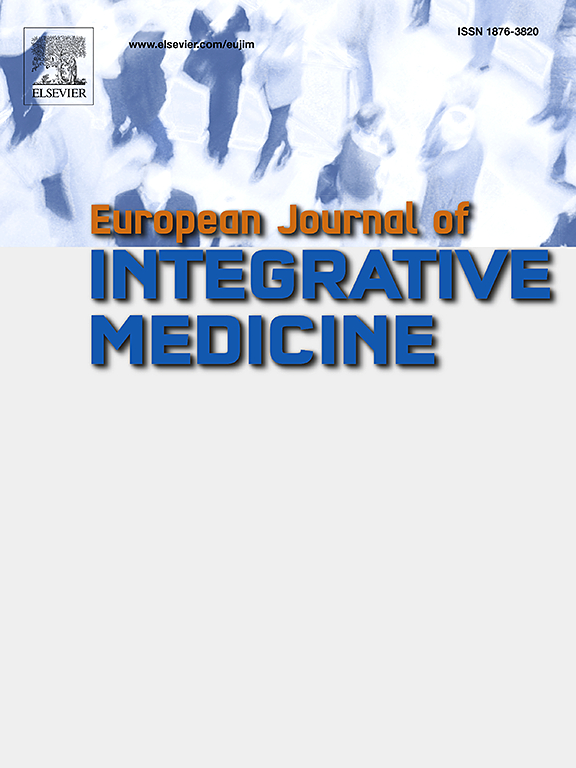Assessment of neuromodulatory effects of Origanum punonense danin essential oil on AMPA receptor function using whole-cell patch-clamp technique
IF 1.7
4区 医学
Q3 INTEGRATIVE & COMPLEMENTARY MEDICINE
引用次数: 0
Abstract
Introduction
: The quest for natural compounds with neuromodulatory properties has gained significant momentum in neuropharmacology. Among these, Origanum punonense (O. punonense) essential oil (EO) stands out due to its rich bioactive profile, particularly characterized by carvacrol. This study aimed to elucidate the effects of O. punonense EO on α-amino-3‑hydroxy-5-methyl-4-isoxazolepropionic acid receptors (AMPAR), crucial synaptic plasticity, and cognitive function mediators.
Methods
: Leaves of O. punonense were collected along the Dead Sea coast in Jericho. After washing, it was dried in the shade for 15 days and ground. Essential oil was extracted using a microwave-ultrasonic method, with ultrasonic waves to enhance extraction. Using whole-cell patch-clamp techniques, we studied the effects of O. punonense EO on AMPAR kinetics in HEK293t cells transfected with homomeric and heteromeric subunits.
Results
: O. punonense EO significantly reduced AMPAR's whole-cell currents, indicating a targeted modulation of synaptic responses. Oil administration inhibited the currents for glutamate receptor subunits GluA1 (reduced from 885±58 pA to 342±20 pA), GluA1/2 (from 627±77 pA to 209±36 pA), GluA2 (from 1125±112 pA to 256±37 pA), and GluA2/3 (from 474±79 pA to 125±31 pA). The EO decreased the desensitization rate significantly for GluA2 and GluA2/3 (p < 0.01) and for GluA1/2 (p < 0.05), except for GluA1. In addition, the EO increased the deactivation rate significantly for GluA2 and GluA2/3 (p < 0.01) and for GluA1/2 (p < 0.05), with no effect observed on GluA1.
Conclusions
: This study highlights the possible properties of O. punonense EO and suggests future research to understand its medicinal benefits in neurodegenerative diseases.
利用全细胞膜片钳技术评估牛至丹宁精油对 AMPA 受体功能的神经调节作用
简介:在神经药理学领域,对具有神经调节特性的天然化合物的探索已取得了显著的进展。其中,牛至(Origanum punonense,O. punonense)精油(EO)因其丰富的生物活性成分(尤其是香芹酚)而脱颖而出。本研究旨在阐明牛至精油对α-氨基-3-羟基-5-甲基-4-异恶唑丙酸受体(AMPAR)、重要的突触可塑性和认知功能介质的影响:方法:在杰里科的死海沿岸采集 O. punonense 的叶子。方法:在杰里科死海沿岸采集 O punonense 的叶子,洗净后在阴凉处晾晒 15 天,然后研磨。采用微波-超声波法提取精油,并用超声波增强提取效果。我们使用全细胞膜片钳技术,研究了 O. punonense EO 对转染同源亚基和异源亚基的 HEK293t 细胞中 AMPAR 动力学的影响:结果:O. punonense 环氧乙烷能显著降低 AMPAR 的全细胞电流,这表明它能有针对性地调节突触反应。给油可抑制谷氨酸受体亚基 GluA1(从 885±58 pA 降至 342±20 pA)、GluA1/2(从 627±77 pA 降至 209±36 pA)、GluA2(从 1125±112 pA 降至 256±37 pA)和 GluA2/3(从 474±79 pA 降至 125±31 pA)的电流。除 GluA1 外,环氧乙烷显著降低了 GluA2 和 GluA2/3 的脱敏率(p < 0.01)以及 GluA1/2 的脱敏率(p < 0.05)。此外,环氧乙烷还显著增加了 GluA2 和 GluA2/3 的失活率(p < 0.01)以及 GluA1/2 的失活率(p < 0.05),但对 GluA1 没有影响:本研究强调了O. punonense环氧乙烷可能具有的特性,并建议今后开展研究,以了解其在神经退行性疾病中的药用价值。
本文章由计算机程序翻译,如有差异,请以英文原文为准。
求助全文
约1分钟内获得全文
求助全文
来源期刊

European Journal of Integrative Medicine
INTEGRATIVE & COMPLEMENTARY MEDICINE-
CiteScore
4.70
自引率
4.00%
发文量
102
审稿时长
33 days
期刊介绍:
The European Journal of Integrative Medicine (EuJIM) considers manuscripts from a wide range of complementary and integrative health care disciplines, with a particular focus on whole systems approaches, public health, self management and traditional medical systems. The journal strives to connect conventional medicine and evidence based complementary medicine. We encourage submissions reporting research with relevance for integrative clinical practice and interprofessional education.
EuJIM aims to be of interest to both conventional and integrative audiences, including healthcare practitioners, researchers, health care organisations, educationalists, and all those who seek objective and critical information on integrative medicine. To achieve this aim EuJIM provides an innovative international and interdisciplinary platform linking researchers and clinicians.
The journal focuses primarily on original research articles including systematic reviews, randomized controlled trials, other clinical studies, qualitative, observational and epidemiological studies. In addition we welcome short reviews, opinion articles and contributions relating to health services and policy, health economics and psychology.
 求助内容:
求助内容: 应助结果提醒方式:
应助结果提醒方式:


